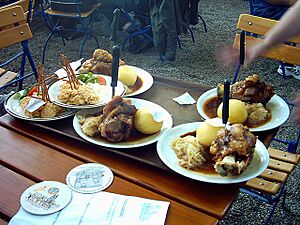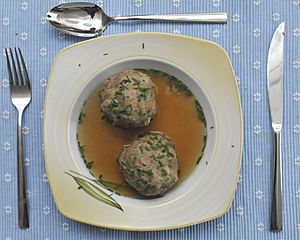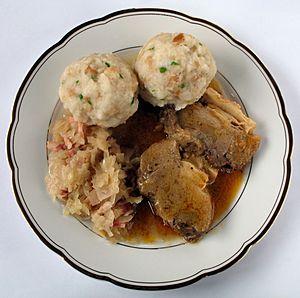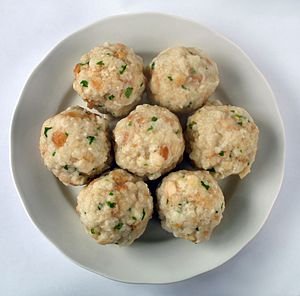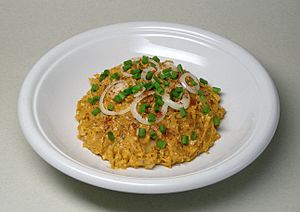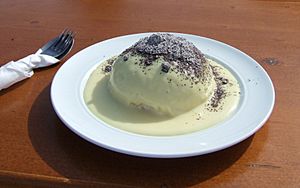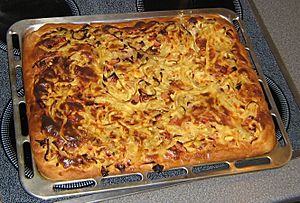Bavarian cuisine facts for kids
Bavarian cuisine is a special way of cooking from Bavaria, a region in Germany. It uses lots of meat and dumplings, and often includes flour. Because of Bavaria's countryside and cool weather, crops like potatoes and beets grow very well. These are important parts of the German diet.
Bavarian dukes, especially the Wittelsbach family, helped make Bavarian food special. They made it fancy enough for royal courts. By the 1800s, this food became popular in wealthy homes, especially in cities. Old Bavarian cooking is very similar to food from Czechia and Austria. This is partly because of royal families like the Wittelsbachs and Habsburgs. Bavarians and their Austrian neighbours have always been close. They share language, culture, and politics, which also shows in their food.
Both groups helped create a unique Bavarian cooking style. It has clear similarities to Franconian and Swabian cuisine. A special Bavarian snack is the Brotzeit. This savoury snack was originally eaten between breakfast and lunch.
Contents
History of Bavarian Food
Cooking traditions in Bavaria go way back to medieval times. People brought different cooking styles to Bavaria with their rulers. This included leaders like Charlemagne.
Bratwurst (a type of sausage) was first mentioned in a document in 1313. The city council of Nuremberg described the recipe as a special local product.
Beer has been brewed in Germany since the Bronze Age. The ancient Germans were likely the first Europeans to brew beer. A rule from 1516, called the Reinheitsgebot, said that beer could only be made with barley, hops, water, and later, yeast. The oldest proof of beer-making in Europe is an old pot found in Kasendorf. It dates back to 800 BCE.
Some people say that noodles came to Bavaria from Marco Polo. He supposedly brought them back after his travels in China. This happened after the Romans had left the area.
During the Napoleonic Wars, Bavaria was occupied by the French. The French influenced many parts of life, including fancy cooking.
Traditional Dishes
Since the late 1800s, people have paid more attention to local foods in different parts of Germany. This was especially true in bigger cities. Cookbooks from that time called "Bavarian" included both country-style dishes and dishes inspired by French cooking. These cookbooks focused on dishes made with flour and dumplings. For most people, even those in cities, meat was usually only eaten on Sundays.
Cookbooks from the 1800s had many recipes for soups with dumplings. Meat recipes often used beef and veal. Cooked beef was common for everyday meals. For pork, suckling pig was very important. A special thing about Bavarian cooking was using all parts of a slaughtered animal. This included things like udders, tripe, and calf heads. These "poor man's dishes" became popular "Schmankerl" (delicacies) in new Bavarian cooking. Head cheese, both sweet and sour, also seems to be a Bavarian specialty.
Dumplings and noodles were traditional festive foods in Bavaria. In the late 1800s, chopped pork with dumplings was a typical Bavarian dish. The Munich Weißwurst (white sausage) was "invented" in 1857. Cookbooks had few recipes for mixed vegetables. Stews were not very common, but Pichelsteiner stew is said to have started in Eastern Bavaria in 1847. In the 1800s, Bavarians mostly ate Sauerkraut and beets. French-influenced dishes included Ragouts, Fricassee, and "Böfflamott" (Boeuf à la Mode). This was beef that was larded (had fat strips added) and marinated. These dishes were mostly for rich people, but later ordinary people also started to eat them.
A report from 1860 said that people in Upper Bavaria often ate dishes with flour, milk, and lard. They added vegetables and ate less meat. Meat was usually only for five main holidays: Carnival, Easter, Pentecost, Kermesse, and Christmas.
Munich Cuisine
The daily food of people in Munich, the state capital, was a bit different from country people's food. City people ate more meat. In the city, more people could afford beef. On holidays, roast veal was a favourite. From 1840 to 1841, Munich had about 83,000 people. Around 77,000 calves were slaughtered, which means about one calf per person! About 20,000 cows were also slaughtered. Beef Bratwursts were especially popular. In the 1800s, potatoes also became part of Bavarian food. However, they were still not as popular as Dampfnudel (steamed dumplings).
A main reason for eating so much veal in Munich was the lack of space. The city had narrow streets and houses. Most people could only keep one or two small animals in their homes. Calves that grew too big had to be slaughtered or sold outside the city.
Not everyone liked Munich's meat-heavy food. One writer in 1907 said that Munich food was based on "eternal calf." He wrote that no other city ate as much veal as Munich. He even said that breakfast often had veal in many forms, like sausages. Dinner and evening meals also had all sorts of veal. He felt that Munich's food was too focused on veal.
List of dishes
Appetisers
Soups
- Bread soup
- Chanterelle soup with Semmelknödel
- Eintopf (a thick stew or soup)
- Griessnockerlsuppe (Semolina Dumplings Soup)
- Semolina Knödel soup
- Hochzeitssuppe (Wedding soup)
- Leberknödelsuppe (Liver dumpling soup)
- Liver Spätzle soup
- Pancake soup
- Sauerne Suppn ("sour soup," made from hardened milk)
- Bacon Knödel soup
Main courses
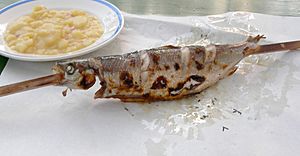
- Saures Lüngerl (sour lungs)
- Roast pork with potato Knödel or Semmelknödel
- Surbraten, roasted cured pork or Haxe (pork knuckle)
- Krustenbraten (roast pork with crispy skin)
- Tellerfleisch (boiled beef)
- Schweinsbraten – A traditional Bavarian roast pork dish common in Upper Bavaria
- Schweinshaxe (roasted pork hock)
- Sauerbraten (marinated roast meat)
- Skirt steak
- Pichelsteiner (a meat and vegetable stew)
- Kalbsvögerl (veal rolls)
- Kesselfleisch (boiled meat)
- Reiberdatschi (potato pancakes)
- Fingernudeln (finger noodles)
- Schupfnudeln
- Schmalznudeln (fried dough)
- Rohrnudeln (baked yeast dumplings)
- Schuxen (fried dough pastry)
- Bröselschmarrn (crumbly pancake)
- Fleischpflanzerl (meatballs)
- Cabbage rolls
- Suckling pig
- Bröselbart (potato crumbs)
- Gnocchi
- Käsespätzle (cheese noodles)
Snacks
- Pretzels
- Kartoffelkäse (potato cheese spread)
- Obatzda (cheese spread)
Delicacies
- Apfelkücherl (apple fritters)
- Bratapfel (baked apple)
- Dampfnudel (steamed dumpling)
- Kaiserschmarrn (shredded pancake)
- Germknödel (yeast dumpling)
- Magenbrot (gingerbread-like cake)
- Garrapinyades (candied almonds)
Desserts
- Apfelstrudel
- Bavarian cream
- Baumkuchen (tree cake)
- Coffee and cake (kaffee und kuchen)
- Dampfnudeln – a steamed dumpling with a sweet fruit sauce
- French toast (Armer Ritter; [lit.] "Poor Knight")
- Bienenstich (bee sting cake)
- Gugelhupf (ring cake)
- Schwarzwälder Kirschtorte (Black Forest cherry cake)
- Prinzregententorte (Prince Regent cake)
- Topfenstrudel (quark strudel)
- Milchrahmstrudel (milk cream strudel)
- Zwetschgendatschi (plum cake)
Sausages and Meat Dishes
Most Bavarian sausages are made using pork.
- Head cheese
- Weißwurst (white sausage) with sweet mustard
- Black pudding
- Bierwurst
- Gelbwurst (yellow sausage)
- Milzwurst (spleen sausage)
- Wollwurst (wool sausage)
- Stockwurst
- Regensburger Wurst
- Leberkäse (meatloaf)
- Wiener Würstchen (Vienna sausages)
Salads
- Bavarian potato salad
- Potato and cucumber salad
- Bavarian Wurstsalat (sausage salad)
- Coleslaw
- Sour Knödel (dumpling salad)
Specialties
Bavaria
- Allerseelenzopf (All Saints' Braid)
- Auszogne (fried dough pastry)
- Bayrisch Kraut (Bavarian cabbage)
- Red cabbage
- Bavarian blue cheese
- Bauernseufzer (farmer's sigh sausage)
- Pretzels
- Böfflamott ("Boeuf à la mode")
- Kartoffelkäse (potato cheese spread)
- Hopfenspargel (hop shoots)
- Fried dough foods
- Horseradish
- Leberkäse (meatloaf)
- Munich onion meat
- Sauerkraut
- Obatzda (cheese spread)
- Asparagus
- Gwixte (a type of cheese)
- Head cheese
- Raphanus (radish)
- Black-smoked ham
- Steckerlfisch (grilled fish on a stick)
- Weisswurst (white sausage)
Bavarian Swabia
- Brenntar (a type of porridge)
- Cheese spätzle (cheese noodles)
- Onion bratwurst
- Bergkäse (mountain cheese)
- Schupfnudel (potato noodles)
Franconia
- Nuremberg bratwurst
- Nuremberg lebkuchen (gingerbread)
- Franconian zwiebelkuchen (onion cake)
- Franconian wood oven bread
- Fruitcake
- Schlachtschüssel (butcher's plate)
- Saure Zipfel (sour sausages)
- Schneeballen (snowball pastry)
- Schäufele (pork shoulder)
Drinks
- Wheat beer
- Pale lager
- Radler (beer mixed with lemonade)
- Märzen (a type of lager)
- Bock (a strong lager)
- Spezi (cola and orange soda mix)
- Shandy (beer mixed with lemonade or ginger beer)
- Bärwurzschnaps (herb schnapps)
- Blutwurzschnaps (root schnapps)
- Enzianschnaps (gentian schnapps)
- Obstler (fruit schnapps)
- Franconian wine
Yiddish Bavarian Cuisine
There is also a type of Bavarian cooking called Yiddish Bavarian cuisine. It includes dishes like:
- Keizershmorrn (shredded pancake)
- Emmental cheese
See also
 In Spanish: Gastronomía de Baviera para niños
In Spanish: Gastronomía de Baviera para niños


